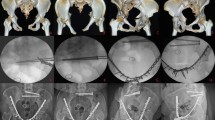Abstract
Objectives
This study aimed to review the epidemiological aspects of acetabular fractures treated at Hamad Medical Corporation in Qatar. The study is the first orthopaedic trauma epidemiological study in Qatar and will provide a platform to advance high-level clinical research.
Methods
We obtained data for 103 patients who presented to our level I trauma centre from 2008 to 2010 with a diagnosis of acetabular fracture. Age, sex, the cause of injury, fracture classification, mode of treatment, associated nerve injuries, and other complications were analyzed.
Results
The incidence of acetabular fracture was 2/100,000/year. Males (93.2%) predominated. The mean age at injury time was 36 years, and the most common cause of injury was motor vehicle collisions (49.5%). Injuries were mostly primary acetabular fractures (73.6%) in comparison to (26.4%) for associated fractures. Posterior wall fractures were the most common pattern (25.2%). Associated posterior hip dislocation occurred in 21.3% of cases. Data revealed a lower incidence of post-traumatic sciatic nerve palsy (7%) that was present at the time of injury. There were no cases of reported mortality.
Conclusion
Acetabular fractures are uncommon injuries with motor vehicle collision being the most common cause of injury. Posterior wall fracture was the most frequent pattern, and most of the patients were males. The incidence of post-traumatic sciatic nerve palsy and the proportion of injured women were lower than those reported in literature. Well-trained surgeons and specialized centres for treating these injuries are recommended.





Similar content being viewed by others
References
Letournel E (1980) Acetabulum fractures: classification and management. Clin Orthop Relat Res 151:81–106
Laird A, Keating J (2005) Acetabular fractures: a 16-year prospective epidemiological study. J Bone Joint Surg, (Br) 87-B:969–973. https://doi.org/10.1302/0301-620X.87B7.16017
Moed BR, Carr SE, Watson JT (2000) Open reduction and internal fixation of posterior wall fractures of the acetabulum. Clin Orthop 377:57–67
Blum J, Beyermann K, Ritter G (1991) Incidence of acetabular fractures before and after the introduction of compulsory seat belt fastening. Unfallchirurgie 17:274–279 (in German)
Al-Qahtani S, O’Connor G (1996) Acetabular fractures before and after the introduction of seatbelt legislation. Can J Surg 39:317–320
Madhu R et al (2006) Outcome of surgery for reconstruction of fractures of the acetabulum—the time-dependent effect of delay. J Bone Joint Surg 86B:1197–1203. https://doi.org/10.1302/0301-620X.88B9.17588
Liebergall M, Mosheiff R, Low J et al (1999) Acetabular fractures: clinical outcome of surgical treatment. Clin Orthop 366:205–216
Mauffre C, Hao J et al (2014) The epidemiology and injury patterns of acetabular fractures are the USA and China comparable? Clin Orthop Relat Res 472:3332–3337. https://doi.org/10.1007/s11999-014-3462-8
Dias MV, Goldsztajn F et al (2015) The epidemiology of acetabulum fractures treated at Instituto Nacional De Traumatologia E Ortopedia. Rev Bras Ortop 45(5):474–477. https://doi.org/10.1016/S2255-4971(15)30438-9
McMaster J, Powell J (2005) Acetabular Fractures. Curr Orthop 19(2):140–154. https://doi.org/10.1016/j.cuor.2005.03.001
Matta JM, Merritt PO (1988) Displaced acetabular fractures. Clin Orthop Relat Res 230:83–97
Johnson EE, Matta JM, Mast JW, Letournel E (1994) Delayed reconstruction of acetabular fractures 21–120 days following injury. Clin Orthop Relat Res 305:20–30
Bozzio AE, Johnson CR, Mauffrey C (2016) Percutaneous management of acetabular fractures as an effective alternative to open reduction and internal fixation. Int Orthop 40:1703. https://doi.org/10.1007/s00264-015-2987-0
Qatar Statistics Authority. Qatar 2010 census of population, housing, and establishments. https://www.mdps.gov.qa/en/statistics/Statistical%20Releases/General/Census/Population_Households_Establishment_QSA_Census_AE_2010_1.pdf
Al-Thani H, El-Menyar A, Consunji R et al (2015) Epidemiology of occupational injuries by nationality in Qatar: evidence for focused occupational safety programmes. Injury 46:1806–1813. https://doi.org/10.1016/j.injury.2015.04.023
Giannoudis PV (2005) Operative treatment of displaced fractures of the acetabulum: a meta-analysis. J Bone Joint Surg Br 87(1):2–9. https://doi.org/10.1302/0301-620X.87B1.15605
Maia M, Santos D et al (2011) Epidemiological analysis of acetabulum. Rev Bras Ortop 46(1):23–26. https://doi.org/10.1590/S0102-36162011000100004
Kim JW, Herbert B, Hao J et al (2015) Acetabular fractures in elderly patients: a comparative study of low-energy versus high-energy injuries. Int Orthop 39:1175–1179. https://doi.org/10.1007/s00264-015-2711-0
Sen RK, Tripathy SK, Aggarwal S, Tamuk T (2011) Posterior wall reconstruction using iliac crest strut graft in severely comminuted posterior acetabular wall fracture. Int Orthop 35:1223–1228. https://doi.org/10.1007/s00264-010-1177-3
Author information
Authors and Affiliations
Corresponding author
Ethics declarations
Conflict of interest
The authors declare that they have no conflict of interest.
Ethical approval
This article does not contain any studies with human participants or animals performed by any of the authors.
Rights and permissions
About this article
Cite this article
Ahmed, M., Abuodeh, Y., Alhammoud, A. et al. Epidemiology of acetabular fractures in Qatar. International Orthopaedics (SICOT) 42, 2211–2217 (2018). https://doi.org/10.1007/s00264-018-3824-z
Received:
Accepted:
Published:
Issue Date:
DOI: https://doi.org/10.1007/s00264-018-3824-z




